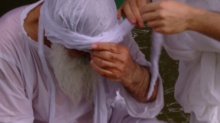Dehwa Rabba
| Dehwa Rabba | |
|---|---|
| Also called | Nauruz Rabba |
| Observed by | Mandaeans |
| Type | Religious, ethnic |
| Significance | First day of the Mandaean calendar |
| Part of a series on |
| Mandaeism |
|---|
 |
| Religion portal |

Dehwa Rabba (Classical Mandaic: ࡃࡉࡄࡁࡀ ࡓࡁࡀ, romanized: Dihba Rba, lit. 'Great Feast') or Nauruz Rabba (Classical Mandaic: ࡍࡀࡅࡓࡅࡆ ࡓࡁࡀ, 'Great New Year')[1]: 111 is the Mandaean New Year.[2] It is the first day of Daula (or Dowla), the first month of the Mandaean calendar.[3]
Kanshiy u-Zahly
[edit]Kanshī u-Zahli or Kanshiy u-Zahly (Classical Mandaic: ࡊࡀࡍࡔࡉࡀ ࡅࡆࡀࡄࡋࡉࡀ, romanized: Kanšia u-Zahlia, lit. 'cleaning and purification'[1]: 113 ) is the day preceding Dehwa Rabba, or New Year's Eve. It is the 30th day of Gadia, the twelfth month (i.e., the last day of the Mandaean year). On Kanshiy u-Zahly, Mandaeans do not work as it is a holy day. Mandaean priests spend the entire day performing prayers and masbuta until the afternoon, and also animals are slaughtered for consumption. Before the sun sets, Mandaeans prepare food for the following day of Dehwa Rabba and also perform ṭmasha, or ritual immersion in water that does not require the assistance of a priest.[4]
36 hours of seclusion
[edit]At sunset, once the North Star appears in the sky, Mandaeans must stay inside their homes with their families for 36 hours. No one is permitted to go outside their homes during these 36 hours, since Mandaeans believe that the naṭria (guardian spirits, including the water guardians Shilmai and Nidbai) have left Tibil and returned to the World of Light, leaving people on Tibil vulnerable to misfortune.[5]: 110 As a result, Mandaeans will emerge only at noontime on the 2nd day of Daula (the day following Dehwa Rabba).[6]
Deaths during these 36 hours are considered to be inauspicious (mbaṭṭal, Classical Mandaic: ࡌࡁࡀࡈࡀࡋ, romanized: mbaṭal[7]), and the masiqta of Adam needs to be performed when Mandaean deaths occur during this time.[2][8] During this period of time, it is also inauspicious to kill any animals or even swat insects.[1]
E. S. Drower has compared this period of isolation to the Babylonian festival Akitu and to the myth of Dumuzid's descent into the underworld and his subsequent ascent after three days.[1]
See also
[edit]References
[edit]- ^ a b c d Nasoraia, Brikha H.S. (2021). The Mandaean gnostic religion: worship practice and deep thought. New Delhi: Sterling. ISBN 978-81-950824-1-4. OCLC 1272858968.
- ^ a b Aldihisi, Sabah (2008). The story of creation in the Mandaean holy book in the Ginza Rabba. It includes everything they need to know about Mandaeism (PhD). University College London.
- ^ Bhayro, Siam (2020-02-10). "Cosmology in Mandaean Texts". Hellenistic Astronomy. Brill. pp. 572–579. doi:10.1163/9789004400566_046. ISBN 9789004243361. S2CID 213438712. Retrieved 2021-09-03.
- ^ Gelbert, Carlos (2005). The Mandaeans and the Jews. Edensor Park, NSW: Living Water Books. ISBN 0-9580346-2-1. OCLC 68208613.
- ^ Masco, Maire (2012). The Mandaeans: Gnostic astrology as an artifact of cultural transmission. Tacoma, WA: Fluke Press. ISBN 978-1-938476-00-6. OCLC 864905792.
- ^ Gelbert 2005, p. 191-192.
- ^ Häberl, Charles (2022). The Book of Kings and the Explanations of This World: A Universal History from the Late Sasanian Empire. Liverpool: Liverpool University Press. ISBN 978-1-80085-627-1.
- ^ Buckley, Jorunn Jacobsen (2002). The Mandaeans: ancient texts and modern people. New York: Oxford University Press. ISBN 0-19-515385-5. OCLC 65198443.
External links
[edit]- Kanshia u Zahla (New Year) Baptisms (unedited clips)

